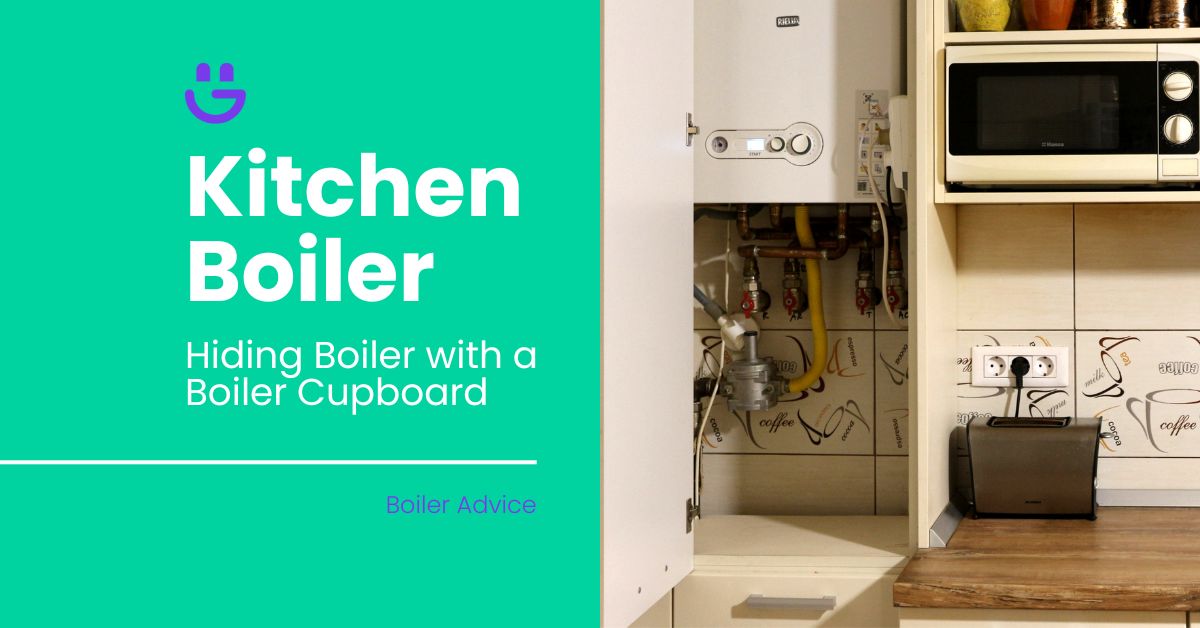Last Updated on April 30, 2024
Are you tired of that unsightly kitchen boiler in your kitchen ruining the aesthetic of your carefully designed space? Well, we can help as we introduce the concept of hiding your boiler in a kitchen cupboard.
This project not only enhances the appearance of your kitchen but also offers a range of benefits while ensuring safety and compliance with regulations. Let’s dive into the world of boiler cupboards and learn how to transform your kitchen space.
Contents
Boiler in Kitchen – Overview
- Selecting a kitchen boiler cupboard involves careful consideration of dimensions and adherence to safety regulations.
- Hiding a boiler in the kitchen offers improved aesthetics, increased home value, noise reduction, and extra storage space.
- Installing a cabinet requires precise measurements for successful installation or exploring other options such as painting it or using curtains while taking into account proper ventilation.
Kitchen Boiler Cupboard
Having a boiler fitted in your kitchen can be quite common, so knowing the effects that this can have on your home is very handy.
Hiding your boiler in a kitchen cupboard is an excellent way to make the most of your space, especially in smaller homes. Boiler housing wall units can be seamlessly integrated into your existing kitchen, providing a more cohesive look.
The key is to find a cupboard that fits your boiler and matches the rest of your kitchen cabinets, ensuring a harmonious design.
The size of a standard kitchen boiler cupboard may vary depending on the model, range, and components used in its construction.
Selecting a boiler cupboard involves careful consideration of the wall-mounted cabinets’ dimensions to guarantee compatibility with your existing larger boiler. Also, considering the space required for extra components like a storage basket might be useful.
Various options are available to fit your specific boiler model. For instance, some retailers offer tower units ranging from 1580mm to 2500mm in height, 150mm to 1000mm in width, and 330mm to 570mm in depth.
Others provide boiler cabinets with a standard depth of 400mm and widths of 500mm or 600mm. Don’t forget to measure your boiler and the available space before choosing a tower unit or boiler housing to ensure great results.
Boiler in Cupboard Regulations
However, it’s not as simple as just covering up your boiler, as there are some guidelines you need to follow first.
Complying with safety regulations is of utmost importance when installing a boiler in a kitchen cupboard. To ensure safe operation and easy access for maintenance, a clearance of 100 mm must be maintained between the cabinet and the base of the boiler, and a clearance of 300 mm should be maintained between the top of the cupboard and the top of the boiler.
There should also be a gap of 50 mm between the boiler and the cabinet door, which reduces any danger risks and gives the boiler more room.
Moreover, the cupboard must meet fire safety standards and provide easy access to the boiler unit and pipework. Before initiating the installation, checking the regulations specific to your location and boiler type is necessary.
Adhering to these regulations guarantees the safety and functionality of your boiler, allowing you to enjoy the benefits of a concealed unit.
Kitchen Boiler Cost
Before you install any of this in your home, we will give you an idea of what price you can end up paying when getting a boiler cabinet.
The cost of installing a kitchen boiler cupboard in the UK can vary from £100 to £500, depending on the location and size of the cupboard. Custom-made kitchen boiler cupboards may range from approximately £75 to over £1000, depending on the size, materials used, and the supplier. For an accurate pricing estimate, it is recommended to contact suppliers directly.
Additional costs to consider when installing a kitchen boiler cupboard may include:
- The price of the new boiler
- Labour for installation
- Custom-built units
- Extra installations such as cylinders or filters
- System cleaning
If you are looking to install a new gas boiler in addition to your boiler cupboard, then you are looking at a higher overall cost. The average cost of a new combi boiler ranges from £1,500 to £3,100, which is determined by the size, type, brand, and power output of the boiler.
Obtaining quotes from professionals is recommended to gain an accurate cost estimate tailored to your specific situation. You should check the price for a new boiler from multiple different manufacturers and installers to make sure you get the best deal.
A comparison of these costs with other boiler concealing methods can aid in making a suitable choice for your home.
Reasons to Hide Your Boiler with a Boiler Cupboard
There are several advantages to hiding your boiler in a kitchen cupboard, including increased storage capacity, maximisation of space, and enhanced visual appeal.
Here, we will go through the benefits of these details, giving you a good idea of what you can gain by hiding your boiler in your kitchen.
Aesthetics
Concealing your boiler in a cupboard can greatly enhance the overall appearance of your kitchen. By hiding the boiler and any associated pipework, you create a more cohesive and visually appealing design.
There are numerous design options available for boiler cupboards in the kitchen, such as concealing the boiler beneath a worktop, constructing a dining alcove with shelves and cupboards, or encasing the boiler in a kitchen cabinet.
To incorporate a boiler cupboard into a kitchen cabinetry design, you can:
- Opt for matching cupboard handles
- Use creative decorating techniques
- Choose a cupboard that complements the style and colour scheme of your existing kitchen
This will ensure a harmonious and well-integrated design, with all essential elements included and the ability to modify as needed.
Value of Your Home
Concealing your boiler in a cupboard can increase your home’s value by making it more visually appealing to potential buyers. A hidden boiler provides a modern and aesthetically pleasing look to the kitchen while freeing up valuable storage space, which is sought after by many buyers.
Installing a boiler cupboard is estimated to boost your property’s value by 4%. However, it’s necessary to guarantee that any hidden boiler systems undergo proper inspection and maintenance to avoid any negative impact on property evaluations.
Kitchens that don’t have their boiler hidden can also bring the value of your home down by £5,000, meaning covering your boiler can be very worthwhile in the long term.
Proper installation and maintenance can help alleviate safety concerns and potential dangers that may affect the overall value of your home.
Noise from Boiler
A kitchen boiler cupboard can help reduce noise from your boiler, creating a more peaceful environment in your home. Here are some ways to soundproof the cupboard:
- Use weatherstripping or a door sweep on the cupboard door to decrease noise.
- Use sound-blocking materials like cork, foam, or fibreglass on the walls of the cupboard.
- Place carpet tiles or a rug inside the cupboard to help absorb noise.
These methods can greatly reduce the noise emitted by the boiler and create a quieter space in your home, especially near doors.
The degree of noise reduction attainable from a kitchen boiler cupboard can vary based on the materials employed and the particular design. By reducing the noise from your boiler, you can enjoy a more serene and tranquil living space, improving the overall quality of life in your home.
Installing a Kitchen Boiler Cabinet
The process of installing a kitchen boiler cabinet involves the following:
- Measuring the space and selecting an appropriately sized cabinet for your specific boiler model that also complements your existing kitchen design.
- Cutting the cabinet to fit the dimensions of your boiler and the available space.
- Attach the cabinet securely to the wall.
To resize the cabinets to the desired size, use a jigsaw, handsaw, or circular saw. Make sure to accurately measure your boiler and the available space in your kitchen before making any cuts. This will help ensure a precise fit and successful installation.
When mounting the cabinet to the wall, ensure that the necessary steps are taken to level and square the cabinet.
This can be done by using construction timber to level out the walls. Correct installation is key to ensuring the safety and functionality of your kitchen boiler cabinet. Hence, it’s beneficial to take your time and verify your measurements and alignments.
Other Ways to Hide Your Boiler
If a kitchen boiler cupboard is not the ideal solution for your home, there are alternative methods for hiding your boiler. Some options include painting the boiler to match the surrounding walls, using curtains to cover the boiler, or creating a custom enclosure tailored to your specific needs.
Each method has its advantages and drawbacks, so please choose the one that works best for you and your requirements.
When contemplating other ways to hide your boiler, maintaining proper ventilation and easy access for maintenance and repairs is significant. Whichever method you choose, taking the time to hide your boiler can greatly improve the overall appearance and functionality of your kitchen space.
Boiler in Kitchen Cupboard – Summary
In conclusion, hiding your boiler in a kitchen cupboard offers numerous benefits, including improved aesthetics, increased home value, and reduced noise.
By following safety regulations and carefully selecting the appropriate cabinet size and design, you can successfully conceal your boiler and transform your kitchen into a more visually appealing and functional space.
Don’t let an unsightly boiler detract from the beauty of your kitchen – consider installing a kitchen boiler cupboard today!
Frequently Asked Questions
Can a boiler be in a kitchen?
Yes, boilers can be installed in a kitchen, with combi boilers being the most suitable option due to their compact size. System and regular boilers can also be installed, although they will take up more space.
How can I hide my kitchen boiler?
Hiding a kitchen boiler can be achieved by building a cabinet around it, installing a panel to match the cabinets, using a room divider or tall plant in the bedroom, fitting it into a kitchen cupboard with cardboard, or enhancing the boiler cover with a sliding door, plant wall, or curtains.
Regular maintenance should also be considered when hiding the boiler.
Can I put a combi boiler in an airing cupboard?
Yes, you can put a combi boiler in an airing cupboard as long as it is room-sealed. Compartment ventilation may need to be installed, and the installation should always be done by a Gas Safe-registered engineer.
What safety regulations should be observed when installing a boiler in a kitchen cupboard?
When installing a boiler in a kitchen cupboard, it’s important to ensure sufficient clearance around the unit, maintain a gap of 100 mm between the cabinet and the base of the boiler, and a gap of 300 mm between the top of the cupboard and the top of the boiler.
On top of this, there should be a 50 mm gap between the cupboard door and the boiler to allow for ventilation and reduce any potential safety risks.
Additionally, the cupboard should meet fire safety standards and provide easy access.
Can concealing a boiler in a cupboard enhance the value of a residence?
Concealing a boiler in a cupboard can enhance the value of a residence by making it more aesthetically pleasing and attractive to prospective buyers.






James Elston
Boiler Expert
James Elston is the top boiler replacement and heating expert at Eco Happy. He has over 20 years of experience in the industry, focusing on Gas Safe boiler installations and offering home-heating and energy-saving solutions to homeowners across the UK. From sourcing the most energy-efficient combi boiler to providing specialist heating advice, James ensures that Eco Happy maintains the highest standards and best customer service.